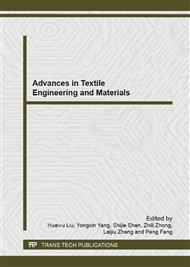p.288
p.293
p.298
p.302
p.307
p.312
p.317
p.321
p.325
Deformation Kinetics of PET/ I-PP Sea-Island Conjugate Fibers in Laser-Heated Flow Drawing
Abstract:
Drawing sea-island fibers heated by CO2 laser could be used as an effective method to produce nano-fibers. The study of deformation model would help us select suitable drawing parameters to manufacture finer fibers. The key parameters of stress/strain equation of PET/i-PP sea-island fibers were obtained by dynamic thermomechanical analysis (DMA) in different temperature. According to the dynamic conditions, the mathematical model of drawing the PET/i-PP sea-island fibers between two rollers was created. The true strain distribution along the fibers by the model was analyzed with the different feed speed and initial stress of the fibers. It is concluded that the appropriate feed speed was 0.15 to 0.66m/min and the initial stress was 8 to 10 Mpa. Moreover, there were two neck points along the fibers which approached and eventually coincided together with the increase of feed speed or with the reduction of the initial stress. The strain distribution was affected by the diameter of laser spot, so was the max strain.
Info:
Periodical:
Pages:
307-311
Citation:
Online since:
December 2012
Authors:
Keywords:
Price:
Сopyright:
© 2013 Trans Tech Publications Ltd. All Rights Reserved
Share:
Citation:


